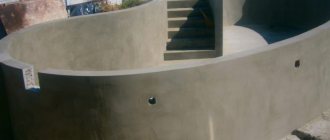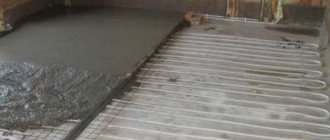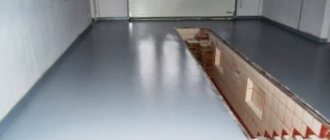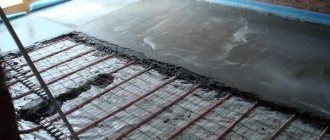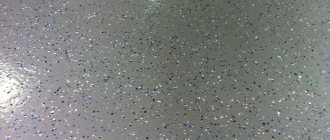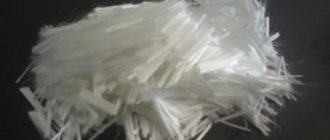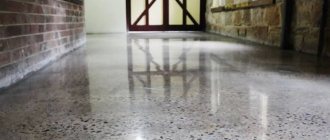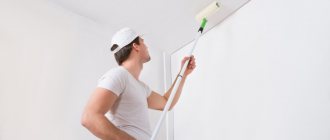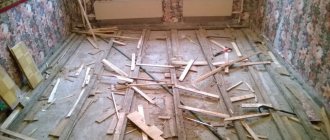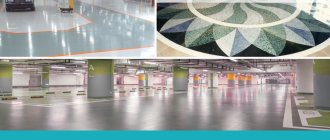In the first part of the article, a review of impregnations was made. Practical issues of technological methods for applying impregnations are also discussed here. Which brands are best for achieving certain goals? How to make impregnation with your own hands? Justification of the popularity and necessity of using toppings.
Why topping is needed and how it works
Concrete has a rough surface that is prone to absorbing water, i.e. Cleaning the premises becomes difficult. In addition, a significant amount of dust accumulates on the floors, which is not easy to get rid of. During operation, sand with particles of cement and sand gradually peel off under the influence of load.
Topping is a liquid or dry coating for concrete surfaces that significantly strengthens the structure of the stone. Its use allows you to solve several problems:
- The wear resistance of the surface increases;
- Increases resistance to mechanical stress;
- Surface dustiness is reduced;
- The surface becomes perfectly smooth;
- The protective coating does not absorb water.
The effect is achieved due to the deep penetration of the topping into the floor surface, sealing the pores of the concrete.
When organizing a concrete floor together with a topping coating, you can save on the quality of concrete - the use of low-grade cement will be compensated by a super-strong layer of protection.
Recommendations for choosing deep penetration formulations
If you need to buy impregnation for concrete, the recommendations presented should be taken into account.
Chemical strengthening of concrete using silicate impregnating compounds is effective for:
- dust removal with minimal financial costs;
- high operating loads on the floor;
- the base has significant flaws and a rough texture.
Epoxy polymer impregnations for concrete are effective for:
- removing dust from mosaic floors;
- intensive exposure to chemicals on concrete;
- high requirements for surface aesthetics.
Topping composition
A heavy-duty protective coating for concrete consists of several active components:
- High grade cement (Portland cement);
- Plasticizers for plasticity, water resistance;
- Dyes, mineral components to improve the aesthetic properties of flooring.
The composition of the topping for concrete may include mineral additives:
- Quartz-based mixtures are the most affordable and widespread. This topping increases the strength of the concrete coating up to 1.5 times; it is used in rooms whose floors are subject to medium loads (public institutions, warehouses, utility rooms);
- Corundum toppings are resistant to abrasion. Their basis is crumbs of corundum (a durable mineral). The strength of concrete increases up to 2 times. The coating is used in rooms where heavy equipment is expected to be placed, light equipment moves, in rooms with high traffic and abrasion (warehouses, production workshops, entrance areas of public buildings, gyms);
- Toppings with metallized filling are the most durable. The high concentration of metal shavings prevents the destruction of the coating as a result of exposure to high transport loads, vibration, and heavy equipment. Topping is used to strengthen floors in industrial premises where heavy equipment is located, including metallized equipment, and where heavy machinery is moved. The disadvantage of the material is the occurrence of areas of surface corrosion under conditions of high humidity.
Technical characteristics of dry topping with different bases are presented in the table:
A separate type of topping composition is chemical. Usually these are liquid solutions that contain modifiers and polymers, which, penetrating into the top layer of concrete, react with the components of the cement mortar, fill the free space, and a gel is formed, which subsequently hardens. The surface is no less durable than when using cement powders.
Requirements for strengthening with waterproofing impregnation
It is not enough to buy water-repellent impregnation or polyurethane impregnation for concrete; the main thing is to use the composition correctly, according to its purpose.
Silicate modifiers should not be used on mosaic floors due to their low effectiveness on this type of coating
General principles that should guide the master:
- the base must be dry, the presence of liquid in the pores of the concrete is unacceptable;
- if the material bubbles during operation, it means that it is applied in too thick a layer or the base is too wet;
- if after drying the impregnation is removed with a film, the concrete surface was poorly treated and contains fats, oils, dust and dirt, moisture;
- if, after applying the first layer, debris, for example, hairs or grains of sand, gets onto the surface, it is removed with medium-grain sandpaper or a spatula;
- if the master is forced to carry out work at subzero temperatures, he should not only select a suitable impregnation, but also make sure that the concrete does not contain frozen water;
- treatment is carried out no earlier than 15 days after the end of concrete pouring, with the exception of some compositions;
- optimal microclimate for work – humidity up to 90%, t 20-25°;
- most impregnations are effective when the temperature of the concrete base is not lower than +10°;
- the composition is applied using a solvent-resistant tool;
- Grouting the concrete with fine quartz sand before applying water-repellent compounds will give the coating anti-slip properties;
- chips and cracks must be sanded;
- safety precautions are shown (use of respirators, mittens, overalls, shoes with rubber soles.
How to prepare impregnation for waterproofing with your own hands
How to impregnate concrete on the street? To create a durable waterproof layer, you can use liquid glass and sand, cement/concrete mortar.
Components for preparing working mixtures:
- liquid glass – 1.5 kg;
- cement-sand mortar, in a ratio of 1:4 - 2.6 kg;
- quartz sand – 1.5 kg;
- concrete mortar – 2.2 kg – recommended for heavy concrete.
The resulting solutions are used for waterproofing walls and floors. The layer thickness should not be lower than 3.0 mm . To increase the strength characteristics of the coating, an additional layer of liquid glass is applied to the finished surface.
Where can you find floors with toppings?
Concrete floors with topping are installed mainly in warehouses and production facilities, in public buildings where there is no need for a decorative coating:
- Warehouses of production and trade organizations;
- Workshops
- Parking lots, garages;
- Clinics, shopping centers;
- Places where people gather - train stations, airports, shopping malls.
In residential premises, protection is practically not used, since it does not provide the desired high aesthetic properties, and its use as a topcoat is impractical.
Types of topping, material consumption
Depending on the type of solid filler, there are:
Other solid fillers can be basalt, iron or silicon carbides, titanium oxide and similar compounds with increased abrasion resistance. The mixtures obtained from them are specialized; they impart antistatic or other specific properties to the floor covering. Reinforcers of this type are sold by foreign manufacturers; a prime example is the Durocem brand. Application under normal conditions is not advisable.
A separate group includes the so-called liquid toppings - impregnations or additives at the kneading stage. These formulations are selected when expected high chemical loads or when coatings are used in conditions of constant humidity. With a similar strengthening effect, the treatment technology with dry mixtures and impregnations differs; if in doubt, how to cover a concrete floor, it is better to consult with specialists.
Consumption depends on the requirements for wear resistance and strength of the coating: for screeds with light loads, backfilling and distribution of 3-5 kg is enough, with medium and high loads – 5-8. The range indicated by the manufacturer is approximate; in most cases, when calculating the amount of material, its upper limit should be taken into account. Compositions without pigments are distributed more economically; the consumption of variants with dyes can reach 7-8 kg/m2.
Technology for processing concrete floors and screeds
Toppings are applied to a well-set but still wet solution. The base does not need additional wetting; the powder is distributed as evenly as possible. The optimal interval for application is considered to be 5-6 hours from pouring the mixture. Grouting begins after the powder has completely darkened; helicopters and similar equipment are used for these purposes.
In large areas this process is carried out using special machines controlled by operators. The coating begins to be used in 7-21 days, depending on the intensity of traffic and loads.
Cost of topping compositions
Dry mixtures for strengthening concrete foundations are sold by domestic and foreign manufacturers; products from Sika, Mapei, Ceresit, BASF, and Praspan have proven themselves.
Source
Advantages and disadvantages
Topping floors have a number of positive qualities, which include the previously listed properties: strength, dust resistance, ease of cleaning, water resistance. It is necessary to name the disadvantages of the coating:
- As befits concrete floors, topping ones have joints;
- The finishing layer is not resistant to aggressive chemical environments, unless otherwise indicated in the characteristics of the specific composition;
- The surface cannot be repaired, only complete renovation. However, this drawback is conditional, since the integrity of the layer is really difficult to destroy, and the surface serves faithfully for at least 15 years, provided that the composition is chosen correctly for use in specific conditions.
Restoration of topping floors
Despite the excellent characteristics of the hardener, various problems with floors may arise. This may be caused by errors when performing work on the device or operating features. In the event of defects, repair measures cannot be avoided.
- In case it happens delamination of the topping floor, but it is not determined visually, but only by a dull sound when exposed to a defective area, the best option for saving the base is considered to be the injection of horizontal voids that have formed between the screed and the reinforcement. For this purpose, highly fluid epoxy or methyl methacrylate agents are used. To introduce them, it is necessary to drill holes into which the composition is pumped. He will be able to glue the layers together. This method is especially effective when separating materials in small areas.
Sometimes such floors need restoration
- If visible delaminations of a local nature (no more than a few tens of centimeters) appear, you can remove the layer and use polymer-based repair compounds or polymer-cement mixtures to eliminate the defect.
- If the area of the destroyed topping layer exceeds 40% of the total area (cracks, chips and potholes have appeared, the reinforcement peels off from the concrete surface), the reinforcing coating must be completely dismantled and another type of base protection (for example, a polymer floor) must be installed. Dismantling is carried out using shot blasting or milling equipment.
What is self-leveling floor
Prices for self-leveling floors "Starateli"
Self-leveling floors "Starateli"
There are restrictions for carrying out restoration work. Basically, they relate to increased requirements for foundations in terms of impact resistance, wear resistance and aesthetics.
But in general, using hardening toppings when constructing concrete bases, it is possible to significantly improve the performance characteristics of floors for both industrial and commercial purposes.
Topping flooring technology
Toppings come in two types:
- Dry;
- Liquid.
For both cases, work is carried out using different technologies.
Dry method
Dry toppings are sold in the form of dry mixes in bags of 25, 50 kg. Application is carried out on freshly laid concrete. To work, you will need a topping trolley - a special distributing device that evenly scatters the powder. When installing industrial floors over large areas, manually spreading the mixture is very inconvenient and ineffective. To grind the surface, craftsmen use grinding machines with a large working disk.
- The poured concrete screed is rubbed over the entire area with a grinding machine. This is necessary to level the surface before it sets.
- Using a topping cart, apply the dry mixture in a volume of 2/3 of the total amount in the direction from the windows to the exit. As the powder is poured, it absorbs moisture from the concrete and the necessary crystallization reaction occurs.
- After applying the powder, the concrete is ground again. At this stage, the main leveling and filling of the concrete surface with a fixer occurs.
- Then distribute the remaining powder and allow it to soak.
- The grouting process follows again.
- After 2-3 days (sometimes 24 hours is enough), the frozen surface is cleaned with blade knives. The process is repeated 2-3 times until a mirror surface is obtained.
- According to the technology, it is necessary to cover the surface with curing - a solution that forms a thin film that prevents the evaporation of moisture from the stone while the concrete is hydrating. Curing is applied with a roller or spray method some time after finishing grouting.
- Expansion joints are cut to prevent cracking of concrete during shrinkage and hardening, which will finally stop no earlier than 28 days. The seams are filled with sealant.
The floor can be fully used after 28 days, when the finishing layer, which includes cement, has fully reached its design strength.
The average topping consumption per 1 m2 is 4.5 – 5 kg.
Liquid formulations
The advantage of liquid mortars is that they can be used on both a fresh screed and an existing floor. The effect will be equally good if the application is followed:
- It is necessary to ensure temperature conditions in the room +5…+35°С.
- The surface of the existing concrete coating is thoroughly cleaned of dust, if necessary, concrete or cement repair mortar is poured into cracks and potholes, and when working with a fresh screed, the mortar is polished.
- Liquid topping is applied to the prepared base with a roller or sprayer. It is necessary to monitor its absorption - the solution should be reapplied to areas where rapid absorption has occurred.
The layer thickness should be 2-3 mm above the concrete. Average consumption is 4-5 liters per 1 m2 of surface. The amount of absorption depends on the quality of the concrete base.
Within 1 day, the complete process of polymerization and compaction occurs, the surface becomes perfectly smooth, dense and durable. Excess is washed off with water. You can use the floor within 24 hours.
The undeniable advantages of liquid toppings are their versatility and fast hardening speed. However, for convenience you will have to pay an order of magnitude higher - the polymer material is more expensive than dry sealing powder.
- Exterior finishing
Impregnation brands and prices
Monolith 20-M is a universal-use modifier . The composition is synthesized on a water basis, is not subject to combustion and is environmentally friendly. You can buy Monolit 20-M impregnation at a cost of 1,300 rubles per 10 liters.
Effect of impregnation on the base base:
- reducing the risk of concrete warping and the formation of shrinkage cracks;
- increase in hardness and wear resistance by 30%;
- increase in water resistance indicators by three grades;
- the coating after treatment retains the ability to “breathe”, penetrating 20-30 cm inside;
- reduces the ability of the coating to generate dust;
- increasing resistance to organic acids, fats, petroleum products;
- increasing the adhesion of epoxy and paint coatings. The finished coating has a long service life;
- impregnation consumption for Monolith 20-M concrete is 1 l/3-5 m², which depends on the porosity and general condition of the coating.
The material is designed to increase wear resistance and strength of the base coating, protects against dust formation and is used for preparing screeds for laying carpet, linoleum, tiles, laminate, parquet
Protexil is a composition synthesized for special treatment of floors in industrial facilities . The modifier fills internal voids, protects the base from typical aggressive environments, high transport and mechanical loads.
Impregnation for concrete "Protexil" - technical and operational parameters:
- penetration depth – 5.0 – 10.00 mm;
- operating range t -40 +80°;
- warranty period – six months;
- consumption – 0.3 l/m²;
- drying period – no more than 6 hours, at t +20°;
- for “Protexil” (impregnation for concrete) the price starts from 170 rubles/l.
Aquastone - impregnation for concrete and cement screed is intended for work indoors and outdoors.
Main characteristics:
- t of air and base, suitable for carrying out work - not lower than +5°;
- the surface dries in 5-10 hours at 20°;
- flow rate – 0.2-0.35 l/m²;
- cost of material – 5800 RUR/20 kg.
Ashford formula is an impregnation that can be applied to smooth concrete , reinforced with or without topping. The composition is synthesized to strengthen, remove dust, protect and seal concrete floors. It is a non-flammable, non-toxic, water-based, odorless silicate colored polymer.
Main characteristics:
- composition consumption 1l/3-7m²;
- the material is effective on concrete not lower than M300/B22.5;
- During the service life, a glossy sheen is formed on the waterproofing matte layer.
For protective and dust-removing impregnation for concrete, the price will be 800 rubles/kg.
Polyurethane impregnation for concrete "Elaxor PU" is a one-component composition that increases the chemical resistance, strength of the base and protects it from dust formation.
Main characteristics:
- work is carried out with bases of grade strength M150/M350;
- two-layer or three-layer application is indicated;
- average composition consumption – 500 g/m²;
- layer-by-layer drying – 3-6 hours;
- for polyurethane impregnation for concrete, the price is 210 rubles/kg.
Probetil is a compound synthesized on an organic basis . This is a deep penetration impregnation, which can be purchased for strengthening and removing dust from concrete bases in garages, basements, and in premises for various purposes. The product can be applied at sub-zero temperatures and successfully restores worn out, old concrete floors. For "Probetil" - impregnation for deep penetration concrete, the price will be 120 rubles / l.
Main advantages
The main advantage of the technique is the ability to extend the life of the concrete screed by strengthening the surface layer. Thanks to the use of additional reinforcing materials, other properties of the monolith are also improved:
The topping floor has less water absorption compared to concrete, which simplifies the cleaning process. The coating becomes more presentable due to pigment additives. This allows you to save money on decorative finishing of the base.
Topping consumption per 1 m2 of concrete floor calculator
Redistribution will make it possible to more effectively use funds allocated but not in demand in a number of regions to cover the existing needs in other regions. The redistribution was developed by the Russian Ministry of Construction based on the results of monitoring and analysis of the general queue of veterans of the Great Patriotic War in need of housing, which revealed a lack of applicants in some regions and not enough.
The first 455 coastal families will receive the keys to apartments in 2023. 20 residential buildings with 2,716 apartments with shops, cafes and useful services, two multi-level above-ground parking lots, areas for recreation and active games, three types of parks and even a spring that will flow into a stream with rapids and obstacles will appear in the Patroclus microdistrict. Residential quarter "Bosphorus Park" in a picturesque area.
At the Eastern Economic Forum, the Ministry for the Development of the Far East and the Arctic, the Republic of Sakha (Yakutia) and the State Corporation Rosatom signed an agreement on the implementation of a carbon-free nuclear generation project in the Arctic zone of the Republic of Sakha (Yakutia), where the first low-power ground-based nuclear power plant will be built ( ASMM). The Minister of Development signed the agreement.
Calculation of consumption High-strength floor screed Starateli S-10 (25 kg)
Fast and inexpensive delivery, as well as unloading and lifting to the apartment on any floor.
Expert advice, assistance in selecting materials and calculating the required quantity.
Return within one month or extended return period until the end of the repair * for only 5% of the cost of materials.
All materials are stored in dry warehouses, have certificates and quality passports.
By clicking on the "Submit" button, you agree to the Privacy Policy
By clicking on the "Submit" button, you agree to the Privacy Policy
Cost of unloading and lifting
The cost of simple unloading of vehicles without lifting to the floor is 1,200 rubles per ton.
The minimum cost for a loader is 300 rubles.
© M-Delivery, 2021
st. Mariupolskaya, 6, office 28. Moscow, 109382
